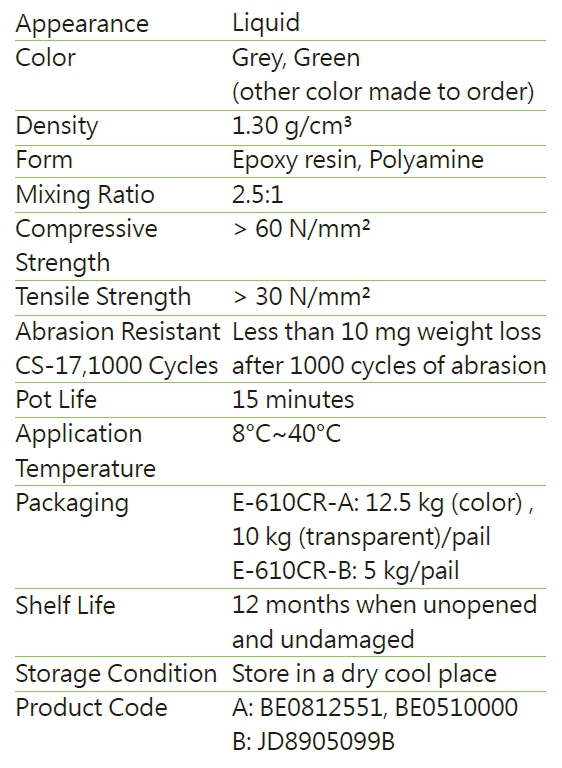
PENTENS E-610CR High Performance, Chemical-resistant Epoxy Resin
PENTENS E-610CR is a 100% solids, pigmented , two-component solvent free epoxy resin. It is highly resistant to acids, alkalis and a broad range of chemicals.
PENTENS E-610CR is ideal for use as a protective coating for concrete and steel in extremely corrosive areas where resistance to 99% Glacial acetic acid and 70% sulfuric acid or other strong caustics is needed.
ADVANTAGES
- Exhibits excellent resistance to strong acids, alkalis, and most industrial chemicals and solvents
- High mechanical loading capacity
- Solvent free
USES
- Food/Drink Factory which will use high concentrate organic acid for washing production process
- PCB or electroplating process
- Chemical plants
- Pulp mills secondary containment areas
- Waste treatment
- Gas and electric utilities
PHYSICAL DATA

APPLICATION
Surface Preparation
Surfaces to be coated must be clean and dry, and free of grease, oil, dirt and other contaminants. Old lining must be completely removed.
Priming
Mineral based substrates must be primed with the low viscosity, solvent-free epoxy resin PENTENS E-500.
Mixing
To premix the E-610CR-A part is necessary to make it homogeneously before mixing with B part. PENTENS E-610CR consists of exact quantities of base and hardener components contained within the same pack. To ensure the correct mixing ratio and for ecological reasons packs should be emptied thoroughly.
Application
Coating:
Application of PENTENS E-610CR is normally by means of brush or roller.
The applied epoxy tank lining must be allowed to cure 72 hours before using the tank for storage of potable water. 7 days curing time is necessary to attain chemical resistance.
Precaution
PENTENS E-610CR will become yellowing when exposure to sunlight but it will be not influence the performance.
SAFETY
Impervious gloves and barrier cream should be used when handling these products.
Eye protection should be worn. In case of contact with eyes, wash thoroughly with plenty of water and seek medical advice if symptoms persist.
If contact with skin occurs, it must be removed before curing takes place.
Wash off with an industrial skin clearer followed by plenty of soap and water. Do not use solvent.
Ensure adequate ventilation when using these products.
